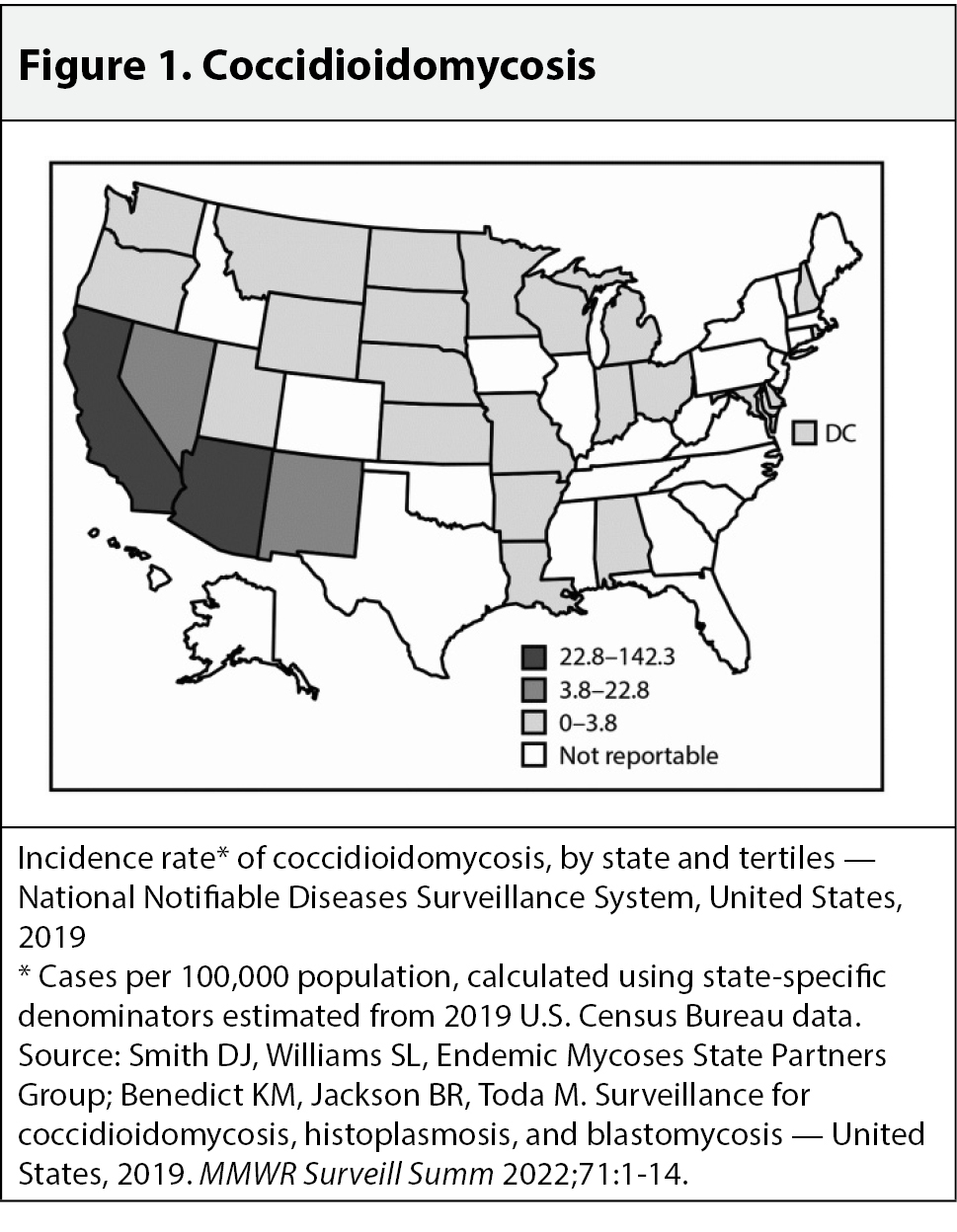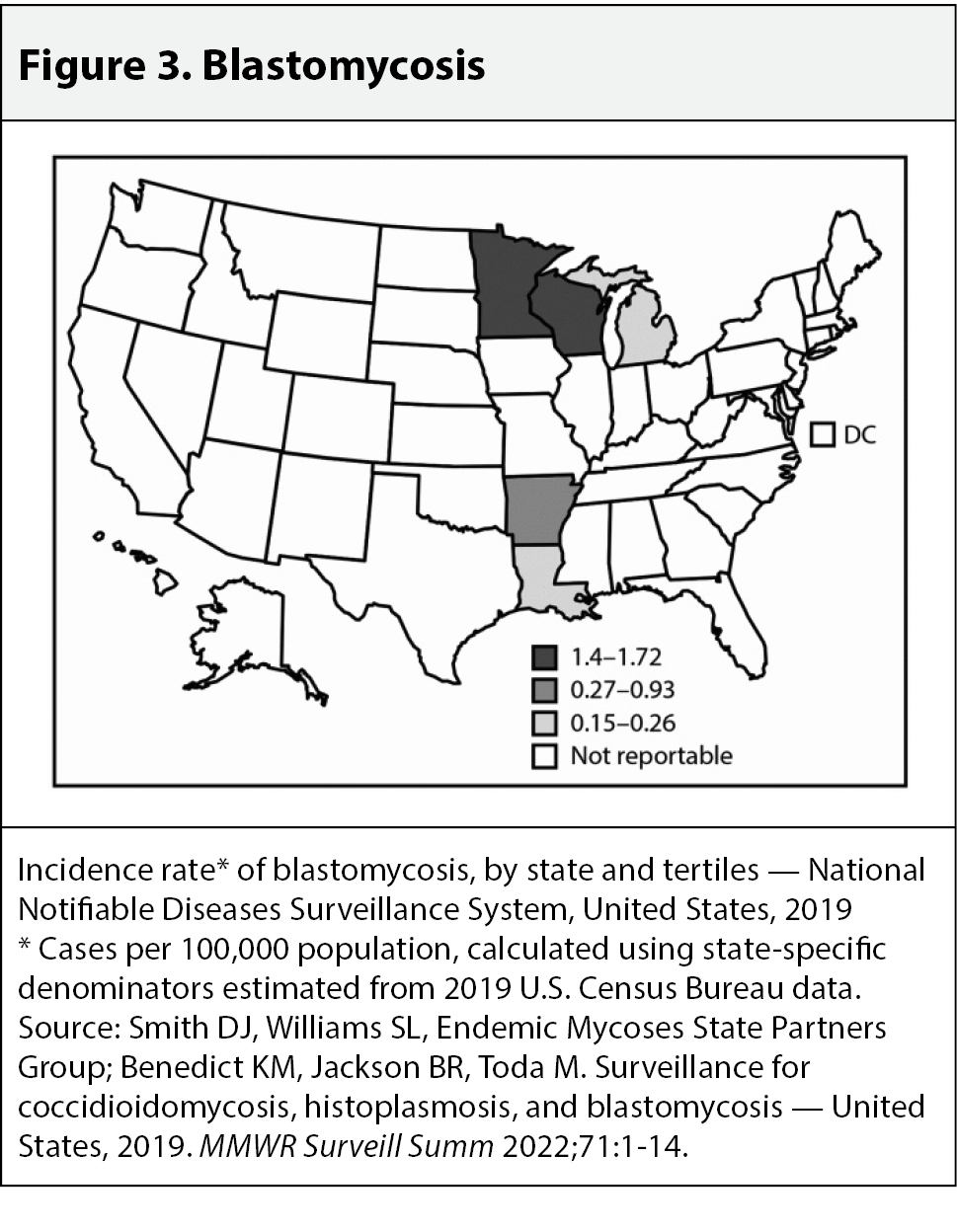By Stan Deresinski, MD, FACP, FIDSA
Clinical Professor of Medicine, Stanford University
SYNOPSIS: In the United States in 2019, 29,061 cases of coccidioidomycosis were reported, as were 1,124 cases of histoplasmosis and 240 of blastomycosis.
SOURCE: Smith DJ, Williams SL, Endemic Mycoses State Partners Group; Benedict KM, Jackson BR, Toda M. Surveillance for coccidioidomycosis, histoplasmosis, and blastomycosis — United States, 2019. MMWR Surveill Summ 2022;71:1-14.
The Centers for Disease Control and Prevention (CDC) has provided its assessment of 2019 U.S. surveillance data of all three endemic fungal infections: coccidioidomycosis, histoplasmosis, and blastomycosis. Each of these infections results from the inhalation of fungal spores residing in the environment, most often a soil reservoir.
Histoplasmosis and blastomycosis are reported by 13 and five states, respectively, and this reporting is voluntary. In contrast, coccidioidomycosis cases in 26 states and the District of Columbia are tracked by the National Notifiable Diseases Surveillance System (NNDSS) A total of 29,061 confirmed cases of coccidioidomycosis were reported in 2019, while the numbers of confirmed plus probable cases of histoplasmosis and blastomycosis were 1,124 and 240, respectively — a difference that may be exaggerated by number of reporting states together with underdiagnosis.
COCCIDIOIDOMYCOSIS
This infection, caused by Coccidioides posadasii and Coccidioides immitis, is endemic in the southwestern United States. (See Figure 1.) Coccidioidomycosis was reported by 23 states, but California and Arizona accounted for 97%, with 22.8 and 142.3 cases per 100,000 population, respectively. The highest incidence rates were in individuals 65 years of age and older and 52% were male. When examined by race and ethnicity, the highest incidence rates were in American Indian/Alaska Native (AI/AN) groups and in Hispanics. Symptom onset was slightly more frequent in autumn than in other seasons.

HISTOPLASMOSIS
Histoplasmosis is caused by Histoplasma capsulatum and most often is acquired in states in the Tennessee, Ohio, and Mississippi river valleys, but infection also may be acquired elsewhere in the United States and other countries. (See Figure 2.) A variant, Histoplasma capsulatum var. duboisii, causes disease in Africa. The overall incidence of histoplasmosis in the 12 states from which the CDC received reports was 1.8 cases per 100,000 population. Illinois accounted for 26% of cases with an incidence of 2.3 per 100,000 population. Michigan and Minnesota each reported approximately one-fifth of cases and had incidence rates of 2.3 and 3.8 per 100,000 population, respectively. The highest incidence rates were in individuals 41-80 years of age and 56% were male. There was little difference in incidence rates in a comparison of whites, Hispanics, and AI/AN. The case frequency was slightly higher in autumn than in other seasons. Reporting on hospitalizations and deaths was incomplete, but at least 249 patients were hospitalized and 20 died.

BLASTOMYCOSIS
Blastomycosis is caused by Blastomyces dermatitidisand Blastomyces gilchristiias well as the very rarely reported and recently identified Blastomyces helicus. (See Figure 3.) Blastomycosis is acquired in Midwestern, South Central, and Southeastern states, although the small number of reported B. helicusinfections were acquired in the Western United States. The overall incidence among the 240 cases reported by five states was 0.8 per 100,000 population. Wisconsin and Minnesota together accounted for 75% of cases. The incidence was highest in AI/AN individuals. The incidence by age barred little between 21 and 89 years; cases were most frequent in the summer and autumn. Males accounted for 70% of cases. Among the patients for whom the information was available, 147/228 (65%) were hospitalized and 20/224 (9%) died.

COMMENTARY
This surveillance data suffers from underdiagnosis and underreporting of these infections. Acute infection with Coccidioidesis symptomatic, generally presenting with a flulike illness, often with pneumonia. Unfortunately, studies have shown that patients presenting in this way in endemic areas often are given a diagnosis of standard community-acquired pneumonia and given antibacterial agents, with no testing for coccidioidomycosis. This is undoubtedly even more likely to occur with patients whose illness, acquired during travel to an area of endemicity, sees medical care in a non-endemic region.
This problem is further exacerbated by the fact that infections due to each of these climate-sensitive environmental fungi are increasingly being acquired outside their designated geographic zones with some apparent northward migration. It is reasonable to hypothesize that climate change may be playing a role in this disease migration, which often appears to be in a northward direction.
The male predominance reported here and seen most strikingly with blastomycosis remains incompletely understood. While it may be simply related to greater risk of environmental exposure, biological and genetic factors deserve further exploration.
Among other actions that are important going forward are better clinician education, availability of inexpensive point-of-care tests, and better understanding of which patients should receive antifungal therapy. Public health surveillance must be improved — making histoplasmosis and blastomycosis, like coccidioidomycosis, nationally notifiable diseases is a first step in this regard. Finally, vaccine development, at least for coccidioidomycosis, must be supported.
